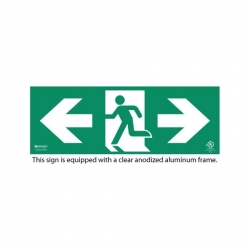









Photoluminescent exit signs are popular for contractors, business owners, and building managers looking for an eco-friendly, code-compliant, and cost-effective way to mark emergency exits. Unlike traditional electric exit signs that require wiring and ongoing energy usage, photoluminescent signs absorb and store ambient light, emitting a glow in low or no light conditions to illuminate exit routes.
As per the Accessibility for Ontarians with Disabilities Act (AODA) and the Tactile Act in Canada, and Section 1024 of the International Building and Fire Codes, properly marked emergency exits are legally required in all public buildings to ensure the safety of all occupants. For business owners, photoluminescent exit signs offer an affordable solution that aligns with environmentally-conscious values. They contain non-toxic, rechargeable photoluminescent panels that charge themselves using existing light fixtures, eliminating the need for hardwiring or electricity.
Photoluminescent exit signs work by absorbing and storing ambient light energy, which is emitted as a bright glow in low or no light conditions. They contain special non-toxic photoluminescent materials, typically zinc sulfide or strontium aluminate, that get charged through exposure to natural or artificial light sources.
Once charged, these materials emit the stored energy as a bright glow for extended dark periods. The illumination duration depends on the charging period, with longer exposure to light resulting in a glow lasting up to 7 hours on a single charge. The light emitted is a bright green that meets or exceeds requirements for emergency exit visibility, ensuring the signs can be seen even at a distance in smoky, chaotic conditions.
One of the biggest benefits of photoluminescent exit signs is their energy efficiency. By tapping into ambient light, they consume no electricity, saving business owners money on energy costs and reducing environmental impact. The signs only require surrounding ambient room lighting to charge, using energy that would otherwise be wasted, and they remain effective for up to 15 years without needing replacement.
Highly Durable
Photoluminescent exit signs are also highly durable, withstanding various environmental conditions. The photoluminescent material is non-toxic, moisture-resistant, and non-flammable. It will continue operating in very hot or wet environments, including outdoor areas exposed to the weather. The signs glow in complete darkness for up to eight hours after a charge, marking exits around the clock.
An additional benefit is that photoluminescent exit signs eliminate the risk of failure during power outages. As they require no hardwiring or electricity, the signs remain fully illuminated even when the main power is disrupted. This ensures all occupants can easily spot exit routes to evacuate the building in an emergency.
Compliance with fire safety regulations and building codes incentivizes businesses to invest in photoluminescent exit signs. They meet the same strict standards as electric exit signs to properly guide occupants to safety in accordance with laws like the Ontario Fire Code. The bright green glow is also highly visible, capturing attention even at a distance in smoky, chaotic conditions. Did you know that according to Section 1024 of the International Building and Fire codes, all buildings are required to have luminous egress path markings installed? This includes the installation of photoluminescent exit signs, which are a great way to ensure that everyone can safely exit a building in case of an emergency.
To meet code compliance, all exit signs must be UL 924 certified, and this means that they have been rigorously tested and are guaranteed to perform when you need them most. So, whether you're a building owner, manager, or just a concerned citizen, it's important to make sure that your building is equipped with the right emergency lighting to keep everyone safe.
Whether battery-powered or hardwired, traditional exit signs provide illumination using a power source that requires ongoing maintenance and costs. The signs rely entirely on their power supply, consuming energy 24 hours daily to stay lit. Batteries must be regularly replaced, often within just 1-2 years, and hardwiring requires professional installation with associated labor fees. Energy usage continues even when exits are not in use, increasing utility costs over the signs' lifetime.
In contrast, photoluminescent exit signs are self-sustaining, absorbing, and re-emitting ambient light to provide bright illumination without any internal power source. They use special non-toxic, rechargeable materials that tap into existing overhead lighting and natural light from windows or skylights to charge. Once charged, they emit a glow for up to 7 hours, even in complete darkness. They require no wiring, batteries, or ongoing maintenance, saving time, money, and the environment.
Photoluminescent exit signs are also highly durable, withstanding heat, humidity, and other extreme conditions for up to 15 years without deterioration. Their non-toxic materials pose no health hazards and continue operating in wet or corrosive environments. Traditional signs, in comparison, often fail prematurely due to battery drain or electrical faults, requiring frequent replacement of components.
During an emergency like a fire or power outage, the reliability and performance of exit signs are critical. Photoluminescent signs provide continuous visibility even when main power is disrupted since they require no external power source. On the other hand, traditional signs may cease working in the event of a power failure, blackout, or distribution issue, putting occupants at risk in an already dangerous situation.
The choice is clear for business owners & contractors prioritizing reduced costs, improved sustainability, and enhanced emergency preparedness. Photoluminescent exit signs are a visibly better solution.
